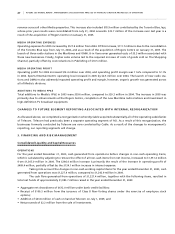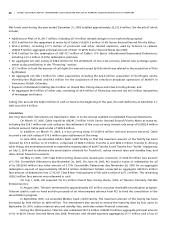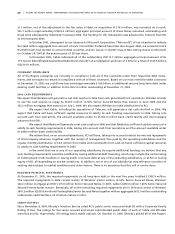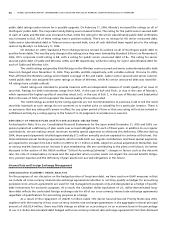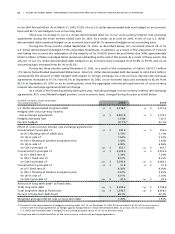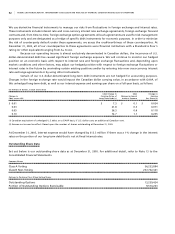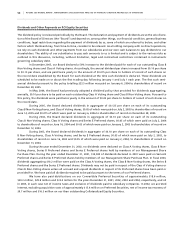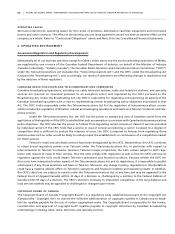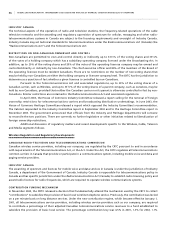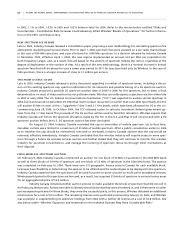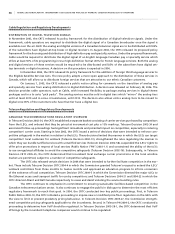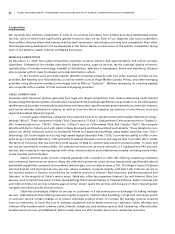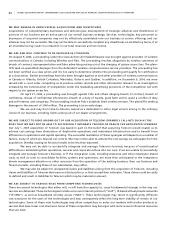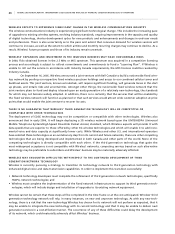Rogers 2005 Annual Report Download - page 60
Download and view the complete annual report
Please find page 60 of the 2005 Rogers annual report below. You can navigate through the pages in the report by either clicking on the pages listed below, or by using the keyword search tool below to find specific information within the annual report.
56 ROGERS 2005 ANNUAL REPORT . MANAGEMENT’S DISCUSSION AND ANALYSIS OF FINANCIAL CONDITION AND RESULTS OF OPERATIONS
IN D U ST R Y C AN A D A
The technical aspects of the operation of radio and television stations, the frequency-related operations of the cable
television networks and the awarding and regulatory supervision of spectrum for cellular, messaging and other radio-
telecommunications systems in Canada are subject to the licensing requirements and oversight of Industry Canada.
Industry Canada may set technical standards for telecommunications under the Radiocommunications Act (Canada) (the
“Radiocommunications Act”) and the Telecommunications Act.
RE S T RI C TI O NS O N N ON - CA N A DI A N O WN E R SH I P A ND C ON T RO L
Non-Canadians are permitted to own and control directly or indirectly up to 331⁄3% of the voting shares and 331⁄3%
of the votes of a holding company which has a subsidiary operating company licenced under the Broadcasting Act. In
addition, up to 20% of the voting shares and 20% of the votes of the operating licencee company may be owned and
controlled directly or indirectly by non-Canadians. The chief executive officer and 80% of the members of the Board of
the operating licencee must be resident Canadians. There are no restrictions on the number of non-voting shares that
may be held by non-Canadians at either the holding company or licencee company level. The CRTC has the jurisdiction to
determine as a question of fact whether a given licencee is controlled by non-Canadians.
Pursuant to the Telecommunications Act and associated regulations, up to 20% of the voting shares of a
Canadian carrier, such as Wireless, and up to 331⁄3% of the voting shares of a parent company, such as ourselves, may be
held by non-Canadians, provided that neither the Canadian carrier nor its parent is otherwise controlled in fact by non-
Canadians. Similar restrictions are contained in the Radiocommunications Act and associated regulations.
In April 2003, the House of Commons Industry Committee released a report calling for the removal of foreign
ownership restrictions for telecommunications carriers and broadcasting distribution undertakings. In June 2003, the
House of Commons Heritage Committee released a report which opposed the Industry Committee’s recommendation.
The Cabinet responded to the Industry Committee report in September 2003 and to the Heritage Committee report in
November 2003. The government announced that officials from the Industry and Heritage departments will convene
to reconcile the two positions. There are currently no further legislative or other initiatives related to liberalization of
foreign ownership restrictions.
Additional discussion of regulatory matters and recent developments specific to the Wireless, Cable, Telecom
and Media segments follows.
Wireless Regulation and Regulatory Developments
CA N A DI A N R AD I O -T E LE V IS I O N A ND TE L E CO M MU N ICA T IO N S C OMM I SS I ON
Canadian wireless service providers, including our company, are regulated by the CRTC pursuant to and in accordance
with requirements of the Telecommunications Act, or the Act. Under the Act, the CRTC regulates all telecommunications
common carriers in Canada that provide or participate in a communications system, including mobile voice and data and
paging service providers.
IN D U ST R Y C AN A D A
The awarding of spectrum and licences for mobile voice and data services in Canada is under the jurisdiction of Industry
Canada, a department of the Government of Canada. Industry Canada is responsible for telecommunications policy in
Canada and has specific jurisdiction under the Radiocommunications Act (Canada) to establish radio licensing policy and
award radio licences for radio frequencies, which are required to operate wireless communications systems.
CO N T RI B UT I ON F UN D IN G M E C HA N IS M
In November 2000, the CRTC released a decision that fundamentally altered the mechanism used by the CRTC to collect
“contributions” to subsidize the provision of basic local wireline telephone service. Previously, the contribution was levied
on a per minute basis on long distance services. Under the new contribution regime, which became effective January 1,
2001, all telecommunications service providers, including wireless service providers such as our company, are required
to contribute a percentage of their adjusted Canadian telecommunications service revenues to a fund established to
subsidize the provision of basic local service. The percentage contribution levy was 4.5% in 2001, 1.3% for 2002, 1.1%



